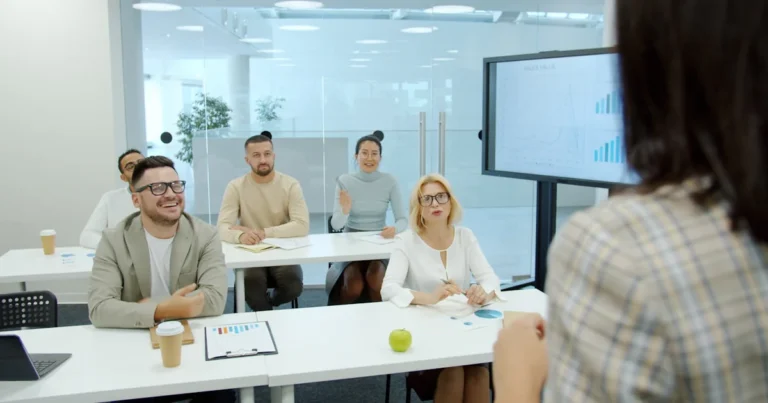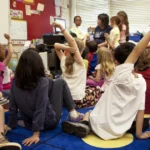Support our educational content for free when you buy through links on our site. Learn more
What Are the 5 Teaching Methods? 🎓 Unlock the Secrets (2025)
Ever sat through a lesson wondering, “Is there a better way to teach this?” You’re not alone! Teaching isn’t just about standing in front of a class and talking—it’s an art and a science, constantly evolving. In this article, we unravel the 5 core teaching methods that every educator should know in 2025, from the classic lecture to inquiry-based learning that sparks curiosity like wildfire. Plus, we’ll dive into bonus strategies, real classroom stories, and how technology like Happy Numbers can transform your teaching game.
Here’s a teaser: Did you know that mixing these methods like a master chef blending spices can dramatically boost student engagement and retention? Stick around, and we’ll show you how to pick the perfect recipe for your unique classroom.
Key Takeaways
- No single method rules all: The best teaching blends multiple approaches tailored to your students’ needs.
- The 5 core methods: Direct Instruction, Inquiry-Based Learning, Cooperative Learning, Differentiated Instruction, and Constructivist Approach form the foundation of effective teaching.
- Technology is your ally: Tools like Happy Numbers and Kahoot! amplify engagement and personalize learning.
- Flexibility is essential: Adapt your methods based on subject, student readiness, and classroom dynamics.
- The 5 Cs matter: Communication, Collaboration, Critical Thinking, Creativity, and Citizenship should be woven into every lesson.
Ready to transform your teaching toolkit? Let’s dive in!
Table of Contents
- ⚡️ Quick Tips and Facts About Teaching Methods
- 📚 The Evolution and History of Teaching Methods
- 1. What Are the 5 Core Teaching Methods?
- 2. Beyond the Basics: 7 Additional Effective Teaching Strategies
- 3. The 5 Cs of Teaching: Communication, Collaboration, Critical Thinking, Creativity, and Citizenship
- 4. How to Choose the Right Teaching Method for Your Classroom
- 5. Technology-Enhanced Teaching Methods: Blending Tradition with Innovation
- 6. Common Challenges in Applying Teaching Methods and How to Overcome Them
- 7. Real-Life Classroom Anecdotes: Teaching Methods That Worked Wonders
- Conclusion: Mastering the Art of Teaching with the Right Methods
- Recommended Links for Further Exploration
- FAQ: Your Burning Questions About Teaching Methods Answered
- Reference Links and Credible Sources
Here is the main body of the article, from “Quick Tips and Facts” to the section before “Conclusion”.
⚡️ Quick Tips and Facts About Teaching Methods
Welcome, fellow educators! You’ve landed at Teacher Strategies™, the ultimate hub for making your classroom buzz with excitement and, dare we say, actual learning. You’re asking, “What are the 5 teaching methods?” and oh boy, are you in for a treat. We’re going to unpack that and so much more. But first, let’s get you warmed up with some rapid-fire facts and tips. Think of this as the espresso shot of pedagogy before we dive into the delicious latte of knowledge.
Here at Teacher Strategies™, we believe in diving deep into Instructional Strategies to find what truly works. While many articles will tell you about what are the five teaching strategies, we’re here to give you the full picture.
| Quick Fact 📊 | The Nitty-Gritty Details |
|---|---|
| Student Engagement Skyrockets | Active learning strategies can increase student performance on exams and concept inventories by nearly half a standard deviation. |
| The “Best” Method is a Myth | The most effective teachers use a blend of methods. As TeachHUB wisely puts it, “success comes from trial and error.” |
| Tech is Your Co-Pilot | Integrating technology isn’t just for fun; it’s essential for connecting with digital-native students and can significantly boost engagement. |
| Collaboration is Key | Cooperative learning doesn’t just improve grades; it also builds critical social and communication skills vital for the 21st-century workplace. |
| Differentiated Instruction Works | Tailoring your teaching to meet individual student needs is a cornerstone of modern education, ensuring every child has a chance to succeed. |
Our Top Tip: Don’t marry one method! The magic happens when you mix and match. Think of yourself as a DJ, blending different teaching tracks to create the perfect learning vibe for your specific crowd of students.
📚 The Evolution and History of Teaching Methods
Ever wonder how we got from rote memorization in a one-room schoolhouse to the dynamic, tech-infused classrooms of today? It’s been a wild ride! The history of teaching methods is a fascinating story of shifting philosophies, from the teacher-as-sage to the teacher-as-guide.
In the old days, the teacher-centered approach was king. The model was simple: the teacher held all the knowledge and dispensed it to students, who were seen as empty vessels. As the Happy Numbers blog describes it, “students passively absorb the information while the teacher actively delivers it.” This method, often called Direct Instruction, has its place, especially for foundational skills, but it can sometimes stifle creativity and critical thinking.
Then came the revolutionaries! Thinkers like John Dewey championed the idea that students learn best by doing. This sparked the shift towards student-centered or constructivist approaches. The core idea? Learning isn’t a spectator sport! eSchool News highlights that in a constructivist model, learning is an active process where students build their own understanding. This philosophy is the bedrock of many modern methods we’ll explore, and it’s a game-changer for effective Lesson Planning.
This evolution is ongoing. Today, we’re focused on blending the best of both worlds, using data and technology to create personalized learning journeys. So, what are the core methods that have emerged from this rich history? Let’s find out.
1. What Are the 5 Core Teaching Methods?
Alright, let’s get to the main event! While there are dozens of strategies out there, most experts agree on a core set of five fundamental methods. These are the building blocks of great teaching. We’ve synthesized insights from across the educational landscape to give you the definitive breakdown.
1.1 Direct Instruction (The Classic Lecture)
This is the OG, the classic, the one you probably picture when you think of “school.” Direct instruction is the teacher-led method where information flows from the expert (you!) to the learners.
One of our veteran teachers, Sarah, calls this her “bedrock method.” “For complex topics in high school physics,” she says, “sometimes you just need to lay out the foundational theory clearly and concisely before you can let them loose to experiment.”
-
✅ Pros:
- Efficient: You can deliver a large amount of information to many students at once.
- Controlled: The teacher controls the content and pacing.
- Foundation-Building: Excellent for introducing new concepts and foundational knowledge.
-
❌ Cons:
- Passive Learning: Can lead to students becoming passive recipients rather than active thinkers.
- One-Size-Fits-All: Doesn’t easily account for different learning paces or styles.
- Engagement Drop-off: It can be tough to keep students engaged for long periods.
1.2 Inquiry-Based Learning
Flip the script! Instead of giving students the answers, inquiry-based learning starts with a question. It’s a student-centered approach that puts curiosity in the driver’s seat. The teacher becomes a facilitator, guiding students as they investigate, explore, and discover knowledge for themselves.
As TeachHUB notes, this method is a “powerful tool for preparing students to tackle the complex problems of the 21st century.”
-
✅ Pros:
- Boosts Critical Thinking: Encourages students to analyze, synthesize, and solve problems.
- Fosters Ownership: Students are more invested in learning when they’re pursuing their own questions.
- Deeper Understanding: Leads to more meaningful and lasting comprehension.
-
❌ Cons:
- Time-Consuming: Can take longer to cover curriculum content.
- Can Be Unstructured: Requires careful planning to keep students on track.
- Risk of Misinformation: Students might reach incorrect conclusions without proper guidance.
1.3 Cooperative Learning
This method is all about teamwork. Students work together in small, structured groups to achieve a common goal. It’s more than just putting kids in a group and hoping for the best; it requires clear roles and shared responsibility.
-
✅ Pros:
- Develops Social Skills: Teaches communication, collaboration, and conflict resolution.
- Improves Retention: Students often learn better when they have to explain concepts to their peers.
- Promotes Equity: Every student has a role to play, encouraging participation from all.
-
❌ Cons:
- Group Dynamics: Can be derailed by personality clashes or unequal participation (the dreaded “group project” curse!).
- Noise and Chaos: Requires strong Classroom Management skills.
- Assessment Challenges: It can be tricky to assess individual contributions accurately.
1.4 Differentiated Instruction
Let’s be real: no two students are the same. Differentiated instruction is the art and science of tailoring your teaching to meet the diverse needs of every learner in your classroom. This isn’t about creating 30 different lesson plans; it’s about offering flexible pathways to learning.
You might differentiate by:
- Content: What the student needs to learn.
- Process: How the student will learn it (e.g., working alone, in a group, using a graphic organizer).
- Product: How the student will demonstrate their learning (e.g., a test, a project, a presentation).
This is the heart of inclusive teaching and a core tenet of our Differentiated Instruction philosophy.
-
✅ Pros:
- Inclusive: Ensures all students, from struggling learners to high-flyers, are challenged appropriately.
- Increases Engagement: Students are more motivated when learning feels accessible and relevant to them.
- Reduces Behavioral Issues: When students feel successful, they’re less likely to act out.
-
❌ Cons:
- Requires Deep Student Knowledge: You need to understand your students’ strengths, weaknesses, and interests.
- Planning Intensive: It takes more time and effort to plan differentiated lessons.
- Resource Demanding: May require a variety of materials and tools.
1.5 The Constructivist Approach
This isn’t just one method, but a whole philosophy that underpins many student-centered strategies. The core idea is that learners actively construct their own knowledge and understanding by connecting new information to their prior experiences.
As the Happy Numbers blog puts it, students are “making sense of what they are learning by relating it to prior knowledge and by discussing it with others.” Think hands-on projects, real-world problem-solving, and collaborative tasks.
-
✅ Pros:
- Active Learning: Students are doers, not just listeners.
- Promotes Metacognition: Helps students think about their own thinking processes.
- Real-World Relevance: Connects classroom learning to students’ lives.
-
❌ Cons:
- Can Be Messy: Learning is less linear and predictable.
- Potential for Gaps: Without careful guidance, students might miss key concepts.
- Requires a Shift in Mindset: The teacher must be comfortable being a facilitator rather than an expert.
So, which of these five is the magic bullet? Surprise! None of them. The real secret sauce is knowing when and how to blend them. But wait… is that all there is? What if we told you the “Top 5” list is just the beginning?
2. Beyond the Basics: 7 Additional Effective Teaching Strategies
You came for five, but we’re Teacher Strategies™—we always give you extra credit! The world of teaching is vast and vibrant. Limiting ourselves to just five methods would be like only using the primary colors. Let’s explore the rest of the palette!
- Project-Based Learning (PBL): A deep dive where students engage in a long-term, real-world project. It’s constructivism in action!
- The Flipped Classroom: Students watch lectures (often online) at home and use class time for hands-on activities, discussions, and problem-solving. It’s homework in reverse!
- The Jigsaw Method: A specific cooperative learning strategy where each student in a group becomes an “expert” on one piece of a topic and then teaches it to the others. TeachHUB highlights this as a fantastic way to ensure every student’s contribution is vital.
- Graphic Organizers: Using visual tools like Venn diagrams, concept maps, and KWL charts to help students structure their thinking. A simple but incredibly powerful tool.
- Montessori Method: A highly student-centered approach, especially popular in early childhood, that emphasizes self-directed activity and hands-on learning in a prepared environment.
- Personalized Education: Taking differentiation to the next level by creating unique learning plans tailored to each student’s individual needs and goals.
- Gamification: Using game-like elements (points, badges, leaderboards) to increase motivation and engagement in learning tasks. Who doesn’t love a good game?
3. The 5 Cs of Teaching: Communication, Collaboration, Critical Thinking, Creativity, and Citizenship
Beyond the “how” of teaching methods, there’s the “what”—the essential skills our students need for the future. Enter the 5 Cs. These aren’t teaching methods themselves, but they are the foundational pillars that should be integrated into any method you choose.
- Communication: Can students clearly express their ideas, both verbally and in writing?
- Collaboration: Can they work effectively in a team, respecting diverse perspectives?
- Critical Thinking: Can they analyze information, solve complex problems, and make reasoned judgments?
- Creativity: Can they think outside the box, innovate, and approach challenges with new ideas?
- Citizenship: Are they developing into responsible, ethical, and engaged members of their community and the world?
No matter if you’re lecturing or facilitating a project, consciously weaving opportunities for students to practice these 5 Cs will elevate your teaching from good to truly transformative.
4. How to Choose the Right Teaching Method for Your Classroom
Okay, you’re armed with a whole arsenal of teaching methods. Now for the million-dollar question: which one do you use on Monday morning? The answer, frustratingly and beautifully, is: it depends.
Choosing the right method is a dynamic process, not a one-time decision. Here’s a checklist our team at Teacher Strategies™ uses to make the call:
| Consider This… | Questions to Ask Yourself |
|---|---|
| Your Students | What are their ages, developmental stages, and prior knowledge? What are their learning preferences and needs? |
| The Subject Matter | Is this a foundational skill that requires direct instruction, or a complex concept best explored through inquiry? |
| Your Learning Objective | What do you want students to know or be able to do by the end of the lesson? (Let the verb guide you: “define” suggests a lecture, while “create” suggests a project). |
| Time & Resources | How much class time do you have? What materials, technology, and space are available? |
| Your Own Strengths | Which methods align with your personality and teaching style? Authenticity is key! |
Remember the wisdom from TeachHUB: “The most effective approach is to experiment with different strategies and adapt them to your unique teaching style and the specific needs of your students.” Don’t be afraid to try something new and, yes, even to fail. That’s how we learn!
5. Technology-Enhanced Teaching Methods: Blending Tradition with Innovation
In today’s world, you can’t talk about teaching without talking about technology. It’s not about replacing great teaching; it’s about amplifying it. Tech can transform a standard lesson into an interactive, engaging, and personalized experience.
Here are some ways to weave tech into your teaching methods:
- Interactive Presentations: Ditch the static PowerPoint and use tools like Pear Deck or Nearpod to embed quizzes, polls, and drawing activities directly into your direct instruction.
- Digital Collaboration: Use platforms like Google Classroom or Padlet to facilitate group work, discussions, and project submissions.
- Gamified Learning: Apps like Kahoot! and Quizlet can turn review sessions into exciting competitions.
- Personalized Practice: This is where technology truly shines. Platforms can adapt to each student’s level, providing targeted practice and immediate feedback.
A great example mentioned in the Happy Numbers blog is Happy Numbers, a digital math resource. It helps teachers implement small group and personalized instruction by providing an adaptive curriculum that meets individual student needs. It’s a fantastic tool for turning the theory of differentiation into a practical reality in your math block.
👉 Shop Happy Numbers on:
6. Common Challenges in Applying Teaching Methods and How to Overcome Them
Let’s get real for a second. Rolling out a new teaching method isn’t always sunshine and perfectly engaged students. You’ll hit bumps. We all do. The key is to anticipate them and have a plan. Here are some common hurdles and advice from our Instructional Coaching experts:
-
Challenge: Student Resistance. (“Why can’t you just tell us the answer?”)
- Solution: Start small. Introduce new methods gradually. Explain the “why” behind the new approach. Celebrate small wins and showcase the benefits of taking ownership of their learning.
-
Challenge: Lack of Resources. (“I’d love to do project-based learning, but I have no budget!”)
- Solution: Get creative! Use free digital tools. Connect with community partners. Focus on projects that use readily available or recycled materials. Sometimes constraints breed the most creativity.
-
Challenge: Time, the Eternal Enemy. (“There’s no way I can cover the curriculum with inquiry-based learning.”)
- Solution: Be strategic. You don’t have to use student-centered methods for every single topic. Use direct instruction for foundational knowledge and save the deeper, inquiry-based dives for the most important, high-leverage concepts.
-
Challenge: Classroom Management Chaos. (“Cooperative learning just turns into a loud party in my room.”)
- Solution: Structure is your best friend. Establish clear norms and roles for group work. Use timers. Model and practice the procedures before diving into academic content. A well-managed classroom is the foundation for any effective strategy.
7. Real-Life Classroom Anecdotes: Teaching Methods That Worked Wonders
Theory is great, but stories are where the magic lies. I’ll never forget the time I tried to teach the water cycle to my fourth graders with a lecture. I had diagrams, I had definitions… and I had 25 blank stares. It was a total flop.
Feeling defeated, I scrapped my lesson plan for the next day. I came in and just put a big question on the board: “The water bottle you’re drinking from has been on Earth for billions of years. Where has it been?”
That one question changed everything. Suddenly, they were the investigators. They worked in groups, drawing wild theories, and begging to go to the library (the library!). We spent the next week on an inquiry-based journey, building terrariums, tracking weather patterns, and creating presentations. They learned more about the water cycle than my lecture could have ever taught them because they lived it.
This is the power of choosing the right method. It’s about creating an experience, not just delivering information. A fantastic framework for creating these experiences is the 5E Instructional Model, which is a research-backed sequence that truly follows the natural progression of learning. It breaks down a lesson into five phases: Engage, Explore, Explain, Extend, and Evaluate. This model provides multiple opportunities for students to interact with content, connect new ideas to what they already know, and achieve that “aha!” moment of deep learning. It’s a perfect roadmap for bringing inquiry and constructivism to life in your classroom.
Conclusion: Mastering the Art of Teaching with the Right Methods
So, what have we uncovered on this whirlwind tour through the world of teaching methods? The big reveal: there is no one-size-fits-all magic bullet. The five core methods—Direct Instruction, Inquiry-Based Learning, Cooperative Learning, Differentiated Instruction, and the Constructivist Approach—are your foundational toolkit. But the real power lies in knowing when and how to blend them, adapting to your unique classroom ecosystem.
Remember our story about the water cycle lesson? It perfectly illustrates the transformation from passive reception to active exploration. That shift is the heartbeat of effective teaching. Whether you’re delivering a crisp lecture or facilitating a hands-on project, your goal is to ignite curiosity, foster collaboration, and build critical skills.
Technology, like Happy Numbers, can be a game-changer, especially when it helps you personalize learning and keep students engaged. While it’s not a silver bullet, it’s a powerful co-pilot when used thoughtfully alongside your instructional strategies.
In the end, your greatest asset is your flexibility and willingness to experiment. Embrace the messiness, celebrate the small wins, and keep your students at the center of every decision. Teaching is an art and a science—and with the right methods, you’re the maestro orchestrating a symphony of learning.
Recommended Links for Further Exploration
Ready to dive deeper or add some powerful tools to your teaching arsenal? Check these out:
-
Happy Numbers:
Happy Numbers Official Website -
Project-Based Learning Resources:
Buck Institute for Education -
Books on Teaching Strategies:
- “The Differentiated Classroom: Responding to the Needs of All Learners” by Carol Ann Tomlinson — Amazon Link
- “Inquiry and the National Science Education Standards: A Guide for Teaching and Learning” by National Research Council — Amazon Link
- “Teach Like a Champion 2.0” by Doug Lemov — Amazon Link
-
Technology Tools for the Classroom:
FAQ: Your Burning Questions About Teaching Methods Answered
What are the most effective teaching strategies for student engagement?
Student engagement thrives when teaching is active, relevant, and varied. Strategies like inquiry-based learning and cooperative learning put students in the driver’s seat, making them active participants rather than passive listeners. Incorporating technology tools such as Kahoot! or Pear Deck can also boost engagement by adding interactivity and instant feedback. Differentiated instruction ensures that tasks are neither too easy nor too hard, keeping students in their “zone of proximal development,” which is crucial for sustained engagement.
How can teachers implement different teaching methods in the classroom?
Implementation is all about intentional planning and flexibility. Start by assessing your students’ needs, the learning objectives, and your available resources. Blend methods to suit the content and context—for example, use direct instruction to introduce new concepts, then follow up with inquiry or project-based activities for deeper exploration. Gradually introduce new methods to students, explaining their purpose to build buy-in. Strong classroom management and clear routines are essential to keep transitions smooth and maximize learning time.
What are the benefits of using varied teaching methods for student learning?
Varied teaching methods cater to diverse learning styles and needs, leading to better outcomes. They promote critical thinking, creativity, collaboration, and communication—skills essential for the 21st century. Using multiple methods also prevents monotony, keeping students motivated and attentive. Moreover, varied methods allow teachers to differentiate instruction effectively, ensuring all students can access and succeed in the curriculum.
How do teaching methods impact classroom management and success?
The choice of teaching methods directly affects classroom dynamics. Methods like cooperative learning require clear structures and roles to prevent chaos, while direct instruction demands attention and focus. Differentiated instruction can reduce behavioral issues by engaging students at their level, decreasing frustration. Effective classroom management strategies go hand-in-hand with teaching methods to create a positive learning environment where students feel safe, respected, and motivated.
How can technology be integrated effectively with traditional teaching methods?
Technology should enhance, not replace, sound pedagogy. Use tech tools to personalize learning, provide immediate feedback, and foster collaboration. For example, platforms like Happy Numbers adapt math practice to individual student levels, while Nearpod can turn a lecture into an interactive experience. The key is to align technology use with your instructional goals and ensure equitable access for all students.
What role does teacher flexibility play in successful teaching?
Flexibility is the secret sauce of effective teaching. No single method works perfectly for every student or every lesson. Being willing to adapt, try new approaches, and reflect on what works allows teachers to meet their students’ evolving needs. Flexibility also models lifelong learning for students, showing them that growth comes from experimentation and resilience.
Reference Links and Credible Sources
- Top 5 Teaching Strategies – TeachHUB
- What Are the 5 Methods of Teaching? – eSchool News
- List of Teaching Methodologies for Primary School – Happy Numbers Blog
- Happy Numbers Official Website
- Pear Deck
- Nearpod
- Kahoot!
- Buck Institute for Education – Project-Based Learning
- National Research Council – Inquiry and the National Science Education Standards
Teaching is a journey, and with the right methods, tools, and mindset, you’re equipped to make it an unforgettable adventure for your students. Keep experimenting, reflecting, and growing—because every great teacher is also a lifelong learner. 🚀








